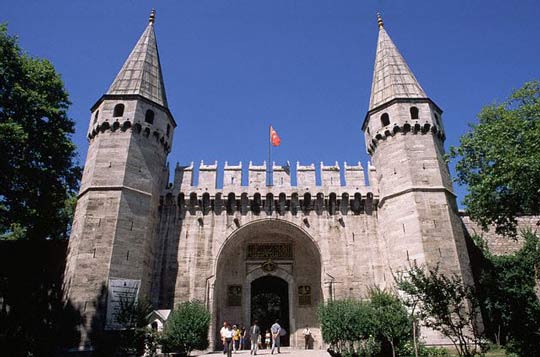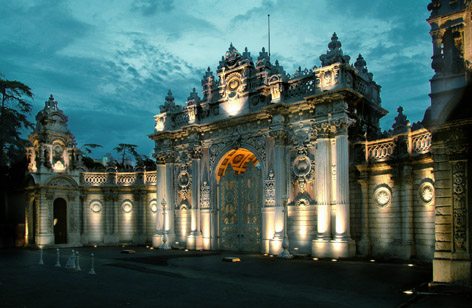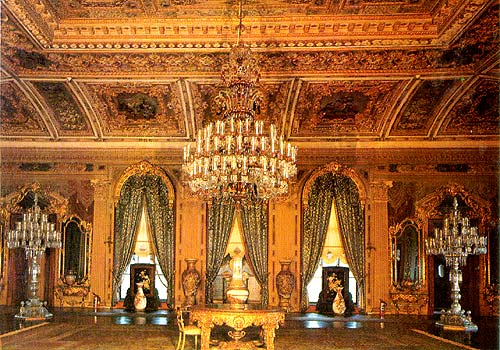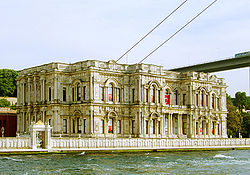Topkapı Palace

One
of the most astounding and popular places to visit in Istanbul is Topkapi Palace,
the symbolic and political centre of the Ottoman Empire in between the 15th and
19th centuries. It stands on the tip of land where the Golden Horn, the Sea of Marmara
and the Bosphorus come together, and is a maze of buildings centered around a series
of courtyards, typical of Islamic tradition. Such is the complexity of each building,
it will take many hours in order to be explored properly.
It was built in between 1466 and 1478, a couple of years before the death of Fatih.
Unlike any European Palace, its architecture is predominantly Middle Eastern in
character. The initial construction was Cinili Mansion, a Glass Palace finished
in 1472, and the imposing main gate facing Sultanahmet, Bab-I Humayun, and the Palace
ramparts, were completed in 1478.
There were originally 750 residents of the Palace, during Fatih's period, which
became drastically more congested reaching 5000 during normal days and 10,000 during
festivals. Extensions had to be built, and the harem was completed in 1595 during
the third Sultan Murad's era, after which the harem residents were moved in from
the palace at Beyazit, with a total of 474 concubines. Special tours of the Harem
are available. The Harem, literally meaning "forbidden" in Arabic, was the suite
of apartments in the palace belonging to the wives, concubines and children of the
head of the household.
Around the Harem there were, Circumcision Room, the apartments of the Chief Black
Eunuch, and apartments of the sultan – in total over 400 rooms. Other highlights
in the Palace are the Spoonmaker's Diamond (the fourth largest diamond in the world),
the Topkapi Dagger, (a gift from Mahmut I), a vast collection of paintings and miniatures,
and the Pavilion of the Holy Mantle (including a footprint, a tooth and a hair of
the Prophet Mohammed).
Opening hours: Daily 09.00 – 17.00, winter closed Tuesday.
Dolmabahçe Palace

Built
in the reign of Sultan I Abdulmecit during the 19th century, this over-ornate palace
lies along the European coast of the Bosphorus. Dolmabahce Palace was constructed
in between 1843 and 1856, mixing different European artistic influences and built
by Abdulmecit's architect, Karabet Balya. It was built over three levels, and symmetrically
planned, with 285 chambers and 43 halls. It has a 600m long pier along the river,
with two huge monumental gates. The palace is surrounded by well-maintained and
immaculate gardens, with an immense 56-columned greeting hall, with 750 lights illuminated
from 4.5 tonnes of crystal chandelier. The entrance was used for meeting and greeting
Sultans, and opposite the ceremonial hall was the harem. The interior decoration,
furniture, silk carpets and curtains all remain with little defect.
The palace has a level of luxury, which has not presented in most other palaces,
with walls and ceilings decorated with gold, and European art from the period. Top
quality silk and wool carpets, southeast Asian hand-made artifacts, and crystal
candlesticks adorn every room. The men's hamam (public bath) is adorned with alabaster
marble, and the harem also contains the Sultan's bedrooms and the women and servants'
divisions. One of the highlights is the throne room, which stands at an amazing
36-metres high – almost twice the height of the rest of the rooms. The east wing
is home to the Museum of Fine Arts.
Opening hours: Daily 09.00 – 16.00, except Monday and Thursday.
Telephone number to book guided tours: (0212) 23 69 600.
Detailed Information
Çırağan Palace

The
most picturesque spots along the Bosphorus and Golden Horn were reserved for the
palaces and mansions for the Sultans, and other important dignitaries, most of which
have now gone. The huge palace was constructed by architect Serkis Balyan in 1871,
as appointed by Sultan Abdul Aziz, from the ruins of the old palace.
The interior construction was rebuilt, at a cost of four million gold coins, beginning
with covering the ceiling with wood and the walls with marble. The rooms were decorated
with rare carpets, furniture, gold and silver. The sides of the building were decorated
with coloured marble, and monumental gates connected it to Yildiz Palace, via a
bridge, which is how the harem women went between the two, in total privacy.
It briefly housed the Turkish Parliament from 1908, but was destroyed by a fire
two years later, and was only rebuilt in 1991. Now, it is Istanbul's premier luxury
hotel, and has retained something of its former glory.
Beylerbeyi Palace

Beylerbeyi,
in which the Asian Tower of Bosphorus Bridge was constructed, is a beautiful district
allotted for palaces since the Byzantium era. Sultan Abdulaziz built the Palace,
to replace the older, wooden palace, between 1861 and 1865. Eastern and Turkish
motifs are used with Western design elements, on the sides and for internal decoration,
and the atmosphere is something resembling that of Dolmabahce Palace.
The building comprises of three floors, and contains 26 rooms and six halls, which
includes the harem and men's greeting rooms. The interior is decorated with Bohemian
chandeliers, valuable tiles and ceramic vases. Silver-edged furniture and luxurious
carpets add something to the beauty, and even till today the authentic furniture,
carpets, curtains and other property have been well preserved.
A big pool, terraces and stables, face at the back of cliff. A road and tunnel,
used until 1970, passed under the palace garden and were used by the most distinguished
foreign dignitaries when visiting the palace.
Open daily except Monday and Thursday.
Yıldız Palace
This vast park consists of mansions, gardens and lakes, the whole area surrounded
by high walls, and all set in a superb hillside location. Popular at weekends and
holidays with locals, it offers one of the few green areas within the city centre,
and is a great place for walking, relaxing and eating. There is a steep walk up
the hill from Ciragan Caddesi up to the first pavilion, but rewards are cooling
breezes and sweeping views of the Bosphorus.
It was in the centre of the Ottoman Empire for 30 years, during the reign of Abdulhamid
II, and the second largest palace in Istanbul. The main structure of Yildiz Palace,
was built in the old Ottoman style and the pavilions which are dotted around the
park were transformed into a power base. The most important remaining building is
Sale Koske, where receptions were held, and is the largest and most ornate and reveals
the luxury in which the sultans lived and entertained. The first section was modelled
on a Swiss Chalet, the second two completed in the late 19th century.
Some of the mansions are undergoing restoration, but Sale is open for visitors,
and two have terraces serving food and drinks. Further along the path is a State
museum, the Belediye Sehir Muzesi, and Yildiz Sarayi Theatre.
Park: Open daily 09.00 – 17.30
Sale Kosku: Open daily 09.30 – 17.00, except Monday and Thursday.
Museum: Open daily 09.00 – 16.30, except Monday.
Detailed Information
Yıldız Porcelain Factory
Kücüksu Small Palace: Built by Abdulmecit I in the mid-19th century, it was used
as a summer residence.
Closed Mondays and Thursdays.
Detailed Information
Aynalıkavak Summer Pavilion :
Built in the early 18th century and later restored by various sultans, this timber
royal pavilion is in the Hasksoy district, on the Karakoy side of the Golden Horn,
incongruously placed between a naval dockyard and cemetery. The last surviving structure
of a large group of buildings, the pavilion is famous for its mirrors, hence its
Mirrored Poplar, which were gifts from the Venetians and installed in 1718. One
of the most beautiful examples of traditional Ottoman architecture, the composition
room, a private room of Ahmet III where he used to compose music, includes a central
brazier and low divans - typical interior of the era.
The pavilion, most recently restored in 2000, also has exhibition of old Turkish
musical instruments. The windows facing the sea are decorated with stained glass.
Opening hours: 09.00 - 16.00, closed Mondays and Thursdays.
Detailed Information
Çinili Köşk (Tiled Pavilion) :
The oldest secular building Istanbul, this was constructed as a mansion in 1472.
It was a type of grandstand from which the Sultan would sit and watch wrestling
or polo, and its interior is beautifully decorated with Selcuk art. It now houses
the Museum of Turkish Ceramics, containing fine example of 16th century tiles from
Iznik, as well as other renowned examples of art and pottery from Selcuk and Ottoman
times.
Closed Mondays.
Ihlamur Köşkü :
The 19th-century Ihlamur Pavilion is named after the linden trees growing in its
gardens. Although now in the heart of metropolitan Istanbul, when it was originally
constructed, the pavilion lay in the rolling countryside that surrounded the city.
The Merasim Pavilion:
This was used for official ceremonies while the Maiyet Pavilion sheltered the sultan's
entourage and, on occasions, his harem on their excursions out of the palace confines.
Closed on Mondays and Thursdays.
Maslak Pavilion :
Maslak Pavilions, situated on a shady green hill, were conceived by Sultan Abdulaziz
as hunting lodges. These are particularly noteworthy as superb examples of the late
19th century Ottoman decorative style.
Closed Mondays and Thursdays.
Florya Atatürk Sea Pavilion :
The Florya Ataturk Sea Pavilion served as a summer residence for Turkish presidents,
beginning with Ataturk. Built in 1935 in a T-shaped design on land jutting out over
the Sea of Marmara, it serves as a showcase for some of the finest examples of early-20th
century furnishings.
Closed Mondays and Thursdays.
Filizi Mansion
Hereke Silk Fabric and Carpet Factory
Yalova Atatürk Mansions
Tekfur Palace